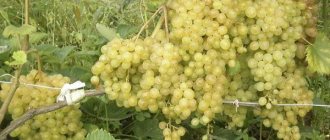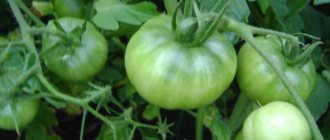| Name | Kishmish Rusbol | Berry color | White with brown tan in the sun |
| Selection | Bulgaria together with VNIIViV named after. Potapenko, Russia, (Villar Blanc x Super early seedless) | Bunch weight | 500 g and above, individual up to 1.5 kg |
| View | Canteen (delicious food), sultanas | Sugar content | Brix over 20 |
| Ripening time | Early (115-125 days) | Bushes | Above average vigor |
| Frost resistance | Increased (-24…-25°С) | Sustainability | Resistance to mildew, oidium, gray rot at the level of 3.0-3.5 points |
| Productivity | High | Presence of a bone | Absent (III-IV class of seedlessness, rudiments are present, up to full-bodied seeds) |
Description of Rusbol grapes
Rusbol grapes are a variety obtained as a result of cooperation between Soviet and Bulgarian breeding scientists. This explains its unusual name - it is formed from the words “Russian” and “Bulgarian”.
This variety belongs to the sultana variety, that is, to varieties that either have no seeds at all or are very small. Rusbol grapes have small soft seeds, which allows us to classify them only as seedless class IV.
The bush itself is of medium size, and over time the strength of its growth increases significantly. The flowers of this grape are bisexual, and due to its long flowering period it can act as a pollinator for other varieties.
Rooted seedlings begin to bear fruit already in the 2nd year. The variety ripens quite early - about 120 days pass from bud break to ripening.
The grapes' berries are oval and relatively small in size; the weight of the berries usually does not exceed 4 g. The color of the fruit is amber-yellow. The berries have a pleasant taste, but not very sweet. The main use of the fruits of this grape is the production of raisins. The skin of the berries is thin, and the seeds are practically not felt when eating.
The clusters are quite dense, the mass of one is about 0.5 kg, but there are also clusters reaching 1-1.5 kg. The shape of the brushes is elongated conical. The peculiarity of this grape is that it is not intended for transportation, but it can be stored for quite a long time.
Comparison with analogues
The main comparison parameters between “rusbol” and other raisin varieties are presented in the table.
| Sign | Variety | |||
| Rusbol | Kishmish Radiant | Kishmish No. 342 (Hungarian) | Jupiter | |
| Ripening period | 115 – 125 days | 125 – 130 days | 110 – 115 days | 110 – 125 days |
| Frost resistance | -25C | -22C | -26C | -29C |
| Yield per bush | Up to 30 kg | 20 – 30 kg | 20 kg | 25 kg |
| Bunches | 400 g – 1.5 kg | Up to 1 kg | 300 – 500 g | 250 – 500g |
| Taste | Light nutmeg | Nutmeg flavor | Nutmeg flavor | Muscat with strawberry aftertaste |
| Color | Amber | Hot pink | Green-golden | Dark blue |
| Disease resistance | Above average | Above average | High | High |
| Shelf life | 1 month | 1 month | 1 month | 3 months |
| Sugar content | 19-21% | 17-21% | 19-21% | 22-23% |
| Acidity | 5.5-7.5 g/l | 6.5-7.5 g/l | 6-8 g/l | 5-6 g/l |
Varieties of grape variety Rusbol
When describing the Rusbol grape variety, it is worth mentioning that it became the basis for the selection of two more varieties of grapes - improved Rusbol and Muscat Rusbol.
Improved Rusbol grapes
The initial varieties for breeding this grape were Rusbol and the hybrid Villa Blanc and Vostorga. The work was also carried out jointly by Soviet and Bulgarian breeders.
Main characteristics of the improved Rusbol variety:
- this grape belongs to the very early grapes - 105-110 days pass from the appearance of the buds to the ripening of the berries;
- fruits appear in the second year after seedlings take root;
- the bush can be successfully combined with any rootstock;
- reviews of improved Rusbol grapes indicate that the variety responds well to care and shows high yield;
- the berry itself is larger than that of the parent variety, the average weight of the bunch is 700-800 g;
- the variety requires mandatory rationing to avoid overloading the vines;
- has good resistance to low temperatures, withstands up to - 25 ° C;
- is highly resistant to most diseases that pose a threat to grape crops;
- as in the parent variety, rudimentary seeds may be present, which allows Rusbol improved to be classified as seedless class III-IV;
- the shape of the berries can be round or oval, the color is white, sometimes with a golden tint;
- The pulp of the fruit is dense, with high sugar content and a pleasant taste.
Based on the photo and description of the Rusbol improved grape variety, it can be noted that it will be an excellent solution for a summer cottage or personal plot.
Rusbol muscat grapes
Another fruit of Soviet-Bulgarian cooperation is the Muscat variety Rusbol. Rusbol and Bulgaria resistant were used in the selection.
Description of the variety:
- like the parent variety, ripening occurs in a fairly short time - about 120 days;
- seedlings demonstrate medium or high growth vigor after rooting;
- it is necessary to ration the harvest so as not to overload the vine and prevent its damage;
- The frost resistance of Rusbol nutmeg is quite high, up to - 23-24 ° C;
- resistance to major grape diseases is high, but there is a danger of infection with oidium, so regular preventive treatment is required;
- The berries of this grape are very large, the average weight of a bunch is 0.4-0.5 kg;
- the berries are white-green in color, round or slightly elongated in shape;
- grapes belong to class IV seedlessness, so small soft seeds can be found in the berries;
- the pulp has a pronounced nutmeg aroma and high sugar content;
- The shelf life of the fruit is higher than that of other varieties of this variety.
Growing rules
Before planting seedlings, it is better to feed the soil with organic fertilizers. This will help it become more fertile and increase the final yield, so 1 bucket of compost and 2 kg of humus are added per m2. It is better to plant in loamy soils with a low acid-base balance. If the acidity of the soil is high, add a limestone solution (2 kg per 10 liters of warm water). The optimal amount of solution is 20 l/m².
The plant is heat-loving, so it is grown in sunny areas. The southern and eastern regions are ideal. Groundwater should not come closer than 3 m to the surface, otherwise it will lead to root rot. It is better to buy a seedling in nurseries, where it is kept in proper conditions. It is grafted and treated with growth stimulants. The planting material should not show signs of disease.
The planting pit is prepared in advance, in the fall. Its width should be 100 cm and depth 80 cm. A drainage system is installed at the bottom to ensure proper circulation of air and water. This helps protect the roots from diseases. A support in the form of a metal rod is driven into the center of the hole, which will support the bush vine and guide it in a vertical direction. Rusbol muscat grapes are placed in a hole, where its roots are evenly distributed over the entire area of the hole. After this, sprinkle everything thoroughly with soil and water with 20 liters of warm water.
Pros and cons of raisin grapes Rusbol
Although Rusbol is not always considered one of the best sultana varieties, it has a number of undeniable advantages:
- grapes demonstrate stable high yields;
- tolerates low air temperatures well, has the ability to self-heal after severe frosts;
- does not require special conditions for cultivation and special care;
- has bisexual flowers, therefore does not require additional pollination, while helping in pollination of other varieties;
- has good resistance to major diseases and pests that pose a threat to grapes;
- refers to early ripening varieties.
At the same time, the variety also has a number of disadvantages:
- due to the large number of massive brushes, there is a risk of damage to the vine, so it is necessary to carry out mandatory crop normalization;
- in rainy weather there is a high probability of cracking of berries;
- fruits do not tolerate transportation well.
But still, most gardeners agree that ease of care and good yield compensate for these shortcomings. Thanks to this, Rusbol remains a very popular choice for growing in the garden.
Unique properties of the plant
Grapes contain a lot of useful minerals and vitamins, which people have known about for thousands of years. In addition to eating, people used sunberries as medicine and various cosmetics.
The substances contained in the plant lower cholesterol levels, strengthen the walls of blood vessels, improve heart function, protect against the formation of kidney stones, improve metabolism, and so on, it’s impossible to list everything. Since ancient times, eating grapes has been especially recommended for quick recovery of strength.
As a cosmetic product, berries containing natural antioxidants are actively used both in home and industrial cosmetology: as part of face masks, to strengthen hair, and as an ingredient for spa treatments.
Due to the relatively low tasting ratings of the variety, the grapes are recommended for fresh use and for drying. However, judging by the reviews of experienced housewives, the fruits of this variety can not only be eaten fresh and dried - the berries can be used for cooking:
- compotes, jelly and jam (in combination with lemon, melon, pear, orange zest, walnuts and so on);
- wines blended with other grape varieties;
- vinegar;
- juice, with various additives.
A number of excellent characteristics inherent in this variety make it indispensable for anyone who is taking their first steps in viticulture and is afraid of being disappointed. Long-term practice of experienced gardeners shows that this variety will invariably delight you with a good harvest, and will not burden you with much trouble in caring for it.
Planting and caring for grapes
For planting Rusbol grapes, it is optimal to purchase ready-made seedlings. When choosing, special attention should be paid to the condition of the roots, they should be strong and elastic, and the buds - they should be large and dense.
Attention! The variety can be planted both in spring and autumn, but April is still considered the most suitable for this.
Selection and preparation of a landing site
At the first stage, it is important to decide on the place where the grapes will grow. A sunny place with light shade, protected from cold drafts, is best suited for this. Grapes do not tolerate waterlogged soil, so you should not choose areas with groundwater close to the surface.
If there are buildings nearby, then you need to step back from them at a distance of about 1.5 m. Next, you need to prepare planting holes 30-40 cm wide and about 50 cm deep. If the soil is clayey, then the size of the holes should be increased. The distance between holes must be at least 2 m.
Landing rules
Planting Rusbol grapes includes the following steps:
- At the bottom of the prepared hole you need to make drainage - 10 cm of crushed stone or expanded clay. It will provide oxygen access to the roots and will not allow excess moisture to accumulate.
- The drainage is sprinkled with a mixture of soil with humus and sand (2 parts of soil, 1 part of sand and compost) to a depth of 5 cm.
- The seedling is carefully placed in a hole, leaving 2 buds on the surface, sprinkled with earth and watered (1 bucket of water is enough).
- You can immediately put a peg or prepare a trellis for the future for gartering shoots.
- When the ground settles, it is necessary to add soil and compact it.
- Sprinkle a layer of mulch on top.
Watering and fertilizing
After planting, the grapes need to be watered approximately once a week at the rate of 1 bucket of water per plant. In wet weather, watering should be adjusted downward. It is not recommended to water the vine during the flowering period and when the berries are ripening. The soil should not be over-moistened - this is detrimental to the grapes.
Rusbol responds very well to fertilizing, so it is recommended to regularly apply organic and mineral fertilizers. The first fertilizing with potassium-phosphorus and nitrogen fertilizers is carried out in early spring, before the buds open. The following can be added before flowering begins. After setting the berries, fertilizers are applied again, excluding nitrogen ones. At the end of the season, the grapes are fed with potassium fertilizers, which will help the plant survive the cold.
Once every 2-3 years in the fall, you can add manure or compost, evenly distributing it over the surface and digging it to a depth of 20 cm.
He also recommends adding ash several times during the season, scattering it around the bush before watering.
Trimming and shaping
Rusbol requires obligatory pruning. Otherwise, massive brushes can simply break the vine. Pruning can be done at the beginning of flowering, when shoots without inflorescences are visible, they must be removed. Repeated pruning is carried out in the fall, leaving no more than 30-40 eyes on the bush. You can do short pruning with 2-3 eyes or medium pruning with 6-7 eyes.
Typically, for this variety, a high-standard molding with medium-length sleeves is used.
How to cover Rusbol grapes
Rusbol belongs to the varieties of non-covering grapes, perfect for the Moscow region and other regions of the middle zone. But it should be taken into account that snowless winters can be destructive for young plants. Therefore, for the first 3 years after planting, experts still recommend covering the grapes for the winter.
Do not cover Rusbol too early when the first frost appears. The plant needs to be given some time to harden - about a week at temperatures down to - 5 ° C. The first step is to protect the roots by covering the soil around the bush with a 10 cm layer of humus. The cut branches are collected in bunches, tied and laid on material that does not allow moisture to pass through (plastic, roofing felt, etc.). It would be a good idea to treat the shoots and soil with a solution of iron sulfate. At the final stage, the shoots are covered with earth, spruce branches or foliage. To prevent excess moisture, a film is placed on top of the arcs, leaving holes for ventilation.
Reproduction methods
Rusbol grapes can be easily propagated on site by cuttings or grafting.
Cuttings
The ripened vine in the fall, before the onset of frost, is cut, placed in sand, and stored in the basement. In the spring, the cuttings are placed in water for a day and planted in containers with soil or wet sawdust. When the seedlings grow up, they are planted on the site.
Graft
Rusbol grapes will show all their best qualities when grafted onto a tall rootstock. The grafting site is wrapped with tape. Fruiting will occur in the 2-3rd year.
Diseases and pests
This grape variety is known for its fairly high resistance to many diseases and pests, but there are still diseases that gardeners should be wary of:
- gray rot (manifests itself in the form of a gray coating on the leaves) - spring treatment with Horus or Insegar or a 1% solution of Bordeaux mixture (100 g of copper sulfate and 150 g of lime per bucket of water) is required;
- oidium (white coating on leaves and berries) - treatment with Karatan or Bayleton helps;
- anthracnose (brown fast-growing spots on the leaves) - for prevention purposes in the spring, treat the vine with a 1% solution of Bordeaux mixture or copper oxychloride;
- mildew (yellowish spots on leaves with white fluff) - prevention with a 1% solution of Bordeaux mixture or Captan or Maneb also helps.
As for insects, the greatest danger is represented by mites, which can be combated by spraying with special means. Otherwise, insect control is not required.
How to plant correctly
Rusbol grape seedlings are purchased from reliable sellers in the garden center or directly from the producers.
Recommendations for choosing deadlines
Experts recommend choosing spring for planting grapes. This way the bushes will have time to take root and grow before the onset of frost. Planting in the fall is also allowed: it must be done a month before the first frost.
How to select and prepare a site
Grapes are planted on the south side of the site: throughout the season it should be well lit by the sun. The soil is selected that is air- and water-permeable and fertile. 2 weeks before planting, a ditch is dug, drainage is laid at the bottom, then a mixture of soil, humus, and mineral fertilizers.
How to select and prepare planting material
In a nursery or garden center, a seedling with an elastic stem and healthy roots, without signs of rotting, is selected. If the root system dried out during transportation, it is soaked in water for 12 hours. A growth stimulator can be added to the water.
Planting scheme
A hole is dug 80-100 centimeters deep and about 1 meter in diameter. When planting several grape bushes, maintain a distance of 2 meters between them. Rusbol grapes are planted as follows:
- dig a hole, lay drainage at the bottom;
- partially fill it with fertile soil;
- install a seedling in the middle, water it abundantly;
- covered with the remains of the fertile substrate.
To prevent the bush from breaking due to gusts of wind, a peg is driven into the hole.
Reviews about grapes
Vesnovskaya Iraida, 52 years old, Kineshma
I have been growing improved Rusbol grapes for four years now. From the second year the vine began to bear fruit - the berries are very large and tasty, there are practically no seeds. The most important thing is to prune in a timely manner, otherwise the grapes will overload themselves and may die.
Salnikov Platon, 36 years old, Yelets
Rusbol was planted the year before last in April. In the first year without fertilizing, the bush gained 1 m in height. Last year I left two shoots and already got my first small harvest. I carried out 3 treatments on it with store-bought fungicides, despite the significant humidity, not a single spot appeared on the leaves.
Poleva Elena, 43 years old, Rtishchevo
I have been growing Rusbol grapes on the plot for several years now. The bushes are vigorous, the vine ripens very well, and the harvest is large. The berries themselves are large, golden-greenish in color, and the taste is very pleasant and sweet. There are small bones.











